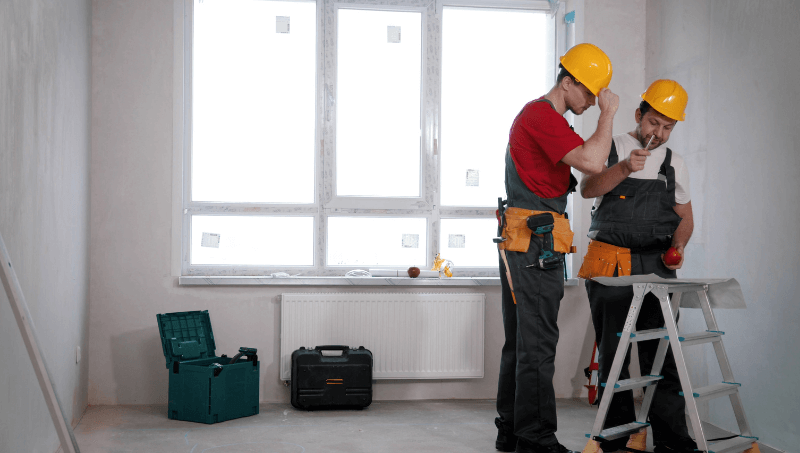
Selling a house can feel like navigating a maze. There are many steps to take and numerous factors to consider, one of which is the lender-required repairs. As a seller, you might view these repairs as a hassle or unnecessary expense. However, understanding their importance and how they play into securing a mortgage for your buyer can help make the process less daunting.
This guide will explain what lender-required repairs are, how to identify them, and importantly, who foots the bill. Arm yourself with this knowledge, and turn what could be a pain point into a smooth transaction for both you and your buyer.
What are Lender-Required Repairs
Lender-required repairs are specific fixes that a financial institution demands before they approve a mortgage on a home. This requirement stems from their interest in ensuring that their investment, which in this case is your home, is in good condition and would retain its value over the term of the loan. These repairs usually address safety, structural, and functionality issues in the property. For instance, a lender may require the repair of a faulty electrical system, a leaking roof, or dysfunctional plumbing. The main aim is to prevent potential home buyers from inheriting a property with hidden defects that could decrease the home’s value or pose risks to the occupants.
What Fixes are Mandatory After a Home Inspection
When it comes to selling a house, it’s crucial to understand that not all home improvements are created equal. Certain repairs are mandatory after a home inspection, especially if you’re aiming to secure a mortgage for the buyer. These lender-required repairs are typically those that directly affect the safety, structure, and functionality of the home.
These may include fixing broken windows, repairing leaky roofs, addressing electrical issues, and replacing damaged HVAC systems. Sometimes, even seemingly minor issues like chipping paint in older homes can be flagged for repairs due to lead-based paint concerns.
Structural defects, such as a crumbling foundation or unstable flooring, are also a priority. Lenders want to ensure their investment is protected, and a house with a weak structure can be a significant risk. Pest issues, like termite infestations, can also imply potential structural problems and can be a cause for mandatory repairs.
Of course, it’s always important to remember that not all repairs will be mandatory after a home inspection. Some issues, while they may detract from the overall appeal or value of the home, do not necessarily impact the home’s safety or functionality. Cosmetic issues, such as outdated fixtures or faded paint, generally don’t make the list of lender-required repairs. It’s vital to distinguish between these mandatory fixes and optional upgrades that could potentially improve the marketability of your home.
What Happens If a Lender Requires Repairs
When a property is under contract for sale, the buyer’s lender may require certain repairs before approving the mortgage. This often happens after the home inspection, when the lender reviews the property’s condition and identifies any potential hazards or structural problems that could affect the home’s value or safety.
As a seller, this can feel like a huge inconvenience, especially if you’re unprepared. You might find yourself asking questions such as, “Why does the lender care about these repairs?” or “Who’s going to pay for this?” The answer to the first question is simple: lenders want to minimize their risk. They’re about to lend a large sum of money and they need to ensure the property is worth the amount. The answer to the second question, however, can be a bit more complex and largely depends on the terms of your sales contract.
In most cases, the seller is responsible for covering the cost of lender-required repairs. This can be a hard pill to swallow, but it’s a necessary step if you want to move forward with the sale. Not taking care of these repairs could lead to the buyer’s mortgage being denied, and consequently, the sale falling through.
While it might seem like a burden, these repairs can ultimately be beneficial. They not only increase the likelihood of the mortgage being approved, but they can also boost your property’s value and appeal, making it more attractive to other potential buyers if the current deal doesn’t pan out.
If you don’t have the extra money to repair your home before selling, you can always consider selling to one of the we-buy houses in Tampa, Florida companies who will purchase your home as-is without requiring any repairs.
Who Pays for Lender-Required Repairs
When the time comes to sell your house with a mortgage, one of the hurdles that sellers may face is dealing with lender-required repairs. These are repairs that a mortgage lender stipulates must be completed before they will lend to a potential buyer of your property. Typically, the buyer’s home inspector pinpoints these issues during a home inspection.
Now, you might be asking, “Who pays for these repairs?” The simple answer is: that it’s negotiable. However, most often it ends up being the seller’s responsibility, especially if you’re in a buyer’s market where competition is high. This is because buyers may have a range of options and can afford to be picky; if one property comes with the additional burden of repair costs, they can simply move on to the next one.
On the other hand, in a seller’s market, where the demand for homes outpaces supply, sellers might have the upper hand. In such situations, a seller could potentially negotiate with the prospective buyer to share or completely cover the repair costs. This will depend on the severity of the repairs needed and the eagerness of the buyer to close the deal.
However, remember that even if you, as the seller, agree to shoulder the repair costs, it’s often in your best interest to do so. Ensuring the repairs are completed may be the key factor in closing the deal and selling your property amid today’s demanding real estate requirements. It might feel like a pain, but at the end of the day, it’s about getting that sale across the finish line.
Avoiding Lender-Required Repairs
Selling a home can be complicated, especially when lender-required repairs come into play. When a potential buyer applies for a mortgage, their lender will typically require a home inspection. If certain repairs are needed, the lender may require these issues to be addressed before approving the mortgage. These repairs can range from minor fixes, like a leaky faucet, to more significant issues, such as structural damage or faulty wiring.
As a seller, these lender-required repairs can be a hassle and a financial burden. But what if there was a way to avoid these repairs altogether and sell your house fast in Florida? Thankfully, an option exists in the form of cash home buyers.
Cash home buyers, as the name suggests, purchase homes outright, for cash. This method bypasses the need for a mortgage, and therefore, the need for a lender-required repair. By selling your home to a cash buyer, you can save the time, money, and stress associated with making repairs and waiting for lender approval.
However, the decision to sell your home to a cash buyer should not be taken lightly. It’s crucial to do your research, understand the process, and evaluate the pros and cons. A cash sale can be quicker, but it might also result in a lower sale price than the market value. Yet, when considering the cost and time of making lender-required repairs, selling to a cash home buyer can often be a beneficial route for sellers who need to sell their Florida homes quickly.
Do You Need to do Lender-Required Repairs
Yes, as a seller, you indeed need to address lender-required repairs. These are mandatory repairs that a mortgage lender requires a homeowner to undertake before a loan can be granted. They typically relate to issues that might seriously impact the safety, security, or structural integrity of the property. For example, if your home has a leaky roof, unstable foundation, or malfunctioning HVAC system, these are likely to be lender-required repairs.
Notably, these repairs are pointed out during a home appraisal or inspection carried out by an expert engaged by the lender. The purpose is to ensure that the home, which serves as collateral for the mortgage, is in good condition and worth the loan amount. If these issues are not addressed, they could significantly degrade the value of your home – making it a risky investment for the lender.
Therefore, if you’re planning to sell your home and your buyer is depending on a mortgage to finance the purchase, you will have to carry out these repairs. It’s a step you cannot skip, because if the lender isn’t confident in the condition of the home, they might not approve the loan, and the sale could fall through. While it may seem like an inconvenience or an unwelcome cost, remember that your ultimate goal is to sell your property, and fulfilling these requirements is often a necessary part of the process.

Conclusion
While the process of addressing lender-required repairs can indeed feel burdensome, it’s an integral part of securing a mortgage for many buyers. If you’re a seller, these repairs may seem like an additional hurdle on your path to finalizing the sale of your property. However, understanding them, and taking proactive steps to identify and address them, can smoothen your selling experience.
One alternative to avoid this issue is selling your property to a cash homebuyer. This option eliminates the need for lender-required repairs altogether, as cash buyers typically purchase properties “as is”. This means they accept the property in its current condition, repairs, and all. It can expedite the sales process, reducing the time and stress involved in preparing your home for sale. But remember, cash buyers might offer less than market value to compensate for the repairs they’ll need to undertake. The choice between managing lender-required repairs or opting for a cash home buyer ultimately hinges on your situation and priorities as a seller.
In summary, seller, you hold the power to decide the most fitting route for yourself. Whether you choose to tackle lender-required repairs or sell to a cash homebuyer, understanding your options is the first step to making an informed decision.

 Call Us!
Call Us!